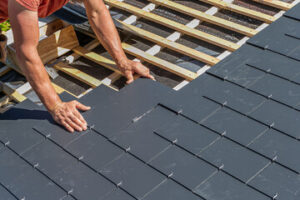A roof is one of the hardest-working parts of a home. It protects the structure from rain, snow, wind and extreme heat and cold.

Roofing materials vary in lifespan, weight and ease of installation. The simplest choice is rolled asphalt shingles. This rolled material can be hammered onto sloped roofs and easily sealed in valleys, the indented spots where roof planes meet. Contact Roofing Montana now!
A metal roof is a type of roofing that uses pieces or tiles made of metallic alloys like aluminum, zinc, and copper. These are usually coated before they’re roll-formed into panels for use as a roof covering on buildings or other structures. These are often used on industrial and commercial buildings but are gaining popularity as residential roofs too, especially for their long lifespans and attractive appearance.
Unlike traditional asphalt shingles, which are made from petroleum, a metal roof is an energy-efficient option. Its reflective properties help keep your home or building cool in summer and warm in winter. In fact, this is one of the main reasons why people choose to go with metal when re-roofing or building their homes.
It’s also extremely durable and can last up to 50 years, making it an excellent choice for homeowners who want a strong, low-maintenance roof. Metal roofs are available in several different panel types and colors, allowing you to create a custom aesthetic for your house. They can complement any architectural style, from traditional to modern.
Most metal roofs are manufactured using galvanized steel or a blend of zinc, aluminum, and copper. These are typically coated with a finish that’s either baked on or spray applied. This coating is what gives the metal its color and protection from corrosion.
The material can be found in a variety of shapes and sizes, including corrugated sheets. It’s most often used on barns, industrial buildings, and agricultural structures because it can withstand a lot of movement.
When it comes to installation, it’s important to hire a professional for this type of job as the panels can be heavy and require precise measurements. In addition, there are often exposed fasteners on these types of roofs and they can be dislodged if not properly secured during installation.
Another drawback to a metal roof is that it can be noisy, particularly when hail or other debris impacts the surface. It’s also not as insulating as some other types of roofs, so you’ll likely spend more on your energy bills during the summer.
Slate
Slate is a natural roofing material that can add a unique beauty to your home. It comes in a variety of colors and textures. Its durable, water-proof, fireproof and stain-resistant properties make it an excellent choice for the roof. It is also a great insulator and can be crafted into a wide range of decorative styles.
It is a fine-grained, foliated metamorphic rock that forms when shale and mudstone are subjected to low-grade regional metamorphism. This metamorphism is caused by changing climates and pressures over long periods of time. Slate is a popular roofing material due to its durability and attractiveness.
In the United States, slate can be found in Vermont and New York. It is mined in these areas and transported to different parts of the country for installation. Slate is available in either hard or soft varieties. It is important to choose the right type of slate for your roof because it has an impact on its life expectancy. Hard slate can last 75-150 years while soft slate has a shorter lifespan.
During the installation process, slate is cut and fitted together to create the desired shape of your roof. This is a highly skilled job that requires an experienced roofer. Once installed, your slate roof will protect your home from wind and hail damage. However, like any roof material it is not indestructible and will require regular maintenance. It is also a very heavy roofing material, which can increase your home’s energy costs.
You may need to repoint or re-waterproof your slate roof as it ages. You may also need to replace the flashing or ridge capping as it deteriorates over time. Slate is also brittle and can break if it is walked on. You will need to call a slate-experienced roofer to repair any broken pieces of the roofing.
Although a beautiful and durable roofing material, slate is more expensive than asphalt shingle roofs. It can cost 3-4 times more than a standard shingle roof. In addition, it is difficult to install. If you live in an area that experiences high winds or a lot of rain, the extra weight of a slate roof could cause it to sag and leak.
Clay Tiles
A terra cotta clay roof adds beauty to your home and is a long-lasting roofing option. They are unaffected by the elements and may last more than 100 years with proper maintenance. Because of their durability and natural aesthetic, a tile roof can increase the value of your home. However, this is a heavy roofing material that requires the frame and structure of your house to be evaluated and possibly reinforced before adding a tile roof. Additionally, clay tiles are very expensive – costing three to four times more than asphalt shingles.
Tile roofs are available in various shapes, sizes and colors to match any architectural design. Flat terra cotta tiles are typically interlocking, with an extrusion on one tile hooking over an edge or channel on an adjacent tile. Other styles include Spanish tile (S-tiles), which have a concave pan and a convex cap, and scalloped clay tiles that provide a distinctive rippled or scaled texture that pairs well with Mediterranean villa designs.
Clay tiles are durable and resist fire, high winds, and heavy rains. They are also energy efficient, holding heat in themselves rather than transferring it to the attic below. Because of their unique look, a clay tile roof can add to the resale value of your property and is an attractive choice for homeowners looking for an exotic touch to their home.
Like all roofing materials, it is important to understand the differences between clay and concrete tiles and how to maintain a clay roof to extend its lifespan. Regular professional cleaning, consultation with a roofing expert about appropriate sealing options, and scheduling annual inspections will help your clay tile roof reach its full life span.
Composite Shakes
Wood shake and slate roofs boost curb appeal and add a premium look to homes. Unfortunately, these roofing materials are prone to organic degradation over time. They can be susceptible to fungus, mold, algae, splintering and rotting. They are also vulnerable to fire. For these reasons, they may not be a good choice in areas with high fire risk or mountain communities. There are alternative roofing options that offer the beauty of cedar shake or slate, without their disadvantages. Composite shakes are made from recycled material and are nearly indistinguishable from natural wood or slate. They are available in a wide range of colors and blends. DaVinci’s synthetic shake shingles are crafted to replicate the thickness and random character of hand-split, natural cedar shakes. They are available in two products: Century Shake, a heavy-profile product for new construction and LudoShake, a lighter-weight option for remodeling.
The advantage of a composite shake is that it’s not susceptible to the same issues as natural cedar, slate and other premium roofing materials. It’s lightweight and a little less expensive than natural materials. It’s a great choice for homeowners that want the look of a natural shake or slate roof, but don’t want the maintenance or fire risks associated with these types of materials.
Composite roofing is manufactured by a process of casting liquid polymers over a mold of the original material. It’s then cured and shaped to imitate the shape of the original roofing. Some manufacturers even incorporate chisel marks to make the shingle appear handmade.
Many homeowners choose composite shingles for the durability and color stability they provide. They are also more resistant to hail and wind damage than natural slate and cedar. Composite shingles are often covered by a lifetime warranty, while natural roofs typically have a 50-year warranty.
Before deciding on a roofing material, homeowners should consult with roofing professionals and experts in the building industry. They can provide insights based on local climate, regulations and structural considerations. They can also help homeowners weigh the pros and cons of different roofing materials. In addition, they can help homeowners find the right roofing product that suits their needs and budget.



